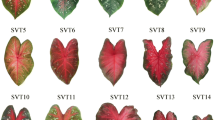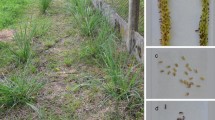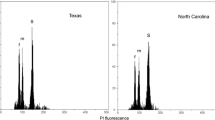Abstract
Seedlings derived from an Actinidia interspecific cross between the hexaploid Actinidia chinensis var. deliciosa ‘Jinkui’ and the diploid male A. eriantha × A. chinensis var. chinensis ‘Chaohong’ hybrid were analyzed using flow cytometry, SSR markers and phenotypic observations. The results show that the leaf vitamin C content of this hybrid population has a mid-parent heterosis. Separation of flower color in the progeny was also observed, progeny with red flowers lighter than ‘Chaohong’, white flowers as in ‘Jinkui’ and intermediate types with a red base to the petals and white margins were all present. Flow cytometry analysis confirmed that most of the progeny were tetraploids, and molecular marker data showed that most of these tetraploid progeny had three alleles from the hexaploid parent and one allele from the diploid parent. UPGMA analysis based on the SSR markers showed that the diploid parent was completely separated from the hexaploid parent and all the progeny.





Similar content being viewed by others
References
An HX, Cai DR, Mu XJ, Zheng B, Shen JG (1995) New germplasm of interspecific hybridization in Actinidia. Acta Hortic Sin 22:133–137
Beatson RA, Datson PM, Harris-Virgin PM, Graham LT (2007) Progress in the breeding of novel interspecific Actinidia hybrids. Acta Hortic 753:147–153
Belrose, Inc. (2008) I. Production of fresh kiwifruit. World Kiwifruit Review 2008 Edn. Pullman, Washington, pp 14
Birchler JA, Auger DL, Riddle NC (2003) In search of the molecular basis of heterosis. Plant Cell 15:2236–2239
Burton TL, Husband BC (2001) Fecundity and offspring ploidy in matings among diploid, triploid and tetraploid Chamerion angustifolium (Onagraceae): consequences for tetraploid establishment. Heredity 87:573–582
Chat J, Dumoulin PY, Bastard Y, Monet R (1996) Cytometric and morphometric identification of diploid, tetraploid and pentaploid plants derived from Actinidia arguta (2n = 4x) crossed with A. deliciosa (2n = 6x). Plant Breed 115:378–384
Chen KK, Chen LG, Liu JJ, Hong QB, Li HW (2006) Study on the trend of inheritance of main characters of citrus fruit. Southwest China J Agric Sci 6:1114–1120
Chen HF, Wang H, Li ZY (2007) Production and genetic analysis of partial hybrids in intertribal crosses between Brassica species (B. rapa, B. napus) and Capsella bursa-pastoris. Plant Cell Rep 26:1791–1800
Cheng CH, Seal AG, Boldingh HL, Marsh KB, Macrae EA, Murphy SJ, Ferguson AR (2004) Inheritance of taste characters and fruit size and number in a diploid Actinidia chinensis (kiwifruit) population. Euphytica 138:185–195
Cho HS, Jo YS, Liu IS, Ahn CS (2007) Characteristics of Actinidia deliciosa × A. arguta and A. arguta × A. deliciosa hybrids. Acta Hortic 753:205–210
Cipriani G, Di Bella R, Testolin R (1996) Screening RAPD primers for molecular taxonomy and cultivar fingerprinting in the genus Actinidia. Euphytica 90:169–174
Cipriani G, Di Bella R, Testolin R (1997) Typing kiwifruit cultivars by means of RAPD markers. Acta Hortic 444:103–108
Cipriani G, Testolin R, Gardner R (1998) Restriction-site variation of PCR amplified chloroplast DNA regions and its implication for the evolution and taxonomy of Actinidia. Theor Appl Genet 96:389–396
Dilkes BP, Comai L (2004) A different dosage hypothesis for parental effects in seed development. Plant Cell 16:3174–3180
Dreisigacker S, Melchinger AE, Zhang P, Ammar K, Flachenecker C, Hoisington D, Warburton ML (2005) Hybrid performance and heterosis in spring bread wheat, and their relations to SSR-based genetic distances and coefficients of parentage. Euphytica 144:51–59
Ellegren H (2004) Microsatellites: simple sequences with complex evolution. Nat Rev Genet 5:435–445
Fan PG, An HX, Cai DR, Mu XJ (2004) Interspecific hybridization between species of Actinidia L. and breeding of superior selection. J Fruit Sci 21:208–211
Ferguson AR, O’Brien IEW, Yan GJ (1997) Ploidy in Actinidia. Acta Hortic 444:67–71
Fraser LG, Harvey CF, Crowhurst RN, De Silva HN (2004) EST-derived microsatellites from Actinidia species and their potential for mapping. Theor Appl Genet 108:1010–1016
Fraser LG, McNeilage MA, Tsang GK, Harvey CF, De Silva HN (2005) Cross-species amplification of microsatellite loci within the dioecious, polyploid genus Actinidia (Actinidiaceae). Theor Appl Genet 112:149–157
Guo WW, Wu RC, Cheng YJ, Deng XX (2007) Production and molecular characterization of Cirtus intergeneric somatic hybrids between red tangerine and citrange. Plant Breed 126:72–76
Gupta PK, Varshney RK (2000) The development and use of microsatellite markers for genetic analysis and plant breeding with emphasis on bread wheat. Euphytica 113:163–185
Guthrie RS, Luby JJ, Bedford DS, McNamara ST (2007) Partial dominance in Actinidia kolomikta interspecific hybrids. Acta Hortic 753:211–218
Halldén C, Hansen M, Nilsson NO, Hjerdin A, Säll T (1996) Competition as a source of errors in RAPD analysis. Theor Appl Genet 93:1185–1192
Harvey CF, Fraser LG, Kent J, Steinhagen S, McNeilage MA, Yan GJ (1995) Analysis of plants obtained by embryo rescue from an interspecific Actinidia cross. Sci Hortic 60:199–212
Hirsch AM, Testolin R, Brown S, Chat J, Fortune D, Bureau JM, De Nay D (2001) Embryo rescue from interspecific crosses in the genus Actinidia (kiwifruit). Plant Cell Rep 20:508–516
Hochholdinger F, Hoecker N (2007) Towards the molecular basis of heterosis. Trends Plant Sci 12:427–432
Huang ZF, LiangMY, Huang CG, Li RG (1983) A preliminary study of the character and nutritive composition of Actinidia fruits. Guihuia 3:53–56, 66
Huang WG, Cipriani G, Morgante M, Testolin R (1998) Microsatellite DNA in Actinidia chinensis: isolation, characterization, and homology in related species. Theor Appl Genet 97:1269–1278
Huang HW, Li ZZ, Li JQ, Kubisiak TL, Layne DR (2002) Phylogenetic relationships in Actinidia as revealed by RAPD analysis. J Am Soc Hortic Sci 127:759–766
Janick J, Moore JN (1996) Fruit breeding. Wiley, Inc., New York
Jo YS, Cho HS, Park MY, Bang GP (2007) Selection of a sweet Actinidia eriantha ‘BIDAN’. Acta Hortic 753:253–258
Jones DF (1917) Dominance of linked factors as a means of accounting for heterosis. Genetics 2:466–475
Kataoka I, Kokudo K, Beppu K, Fukuda T, Mabuchi S, Suezawa K (2003) Evalution of characteristics of Actinidia interspecific hybrid ‘KosuiI’. Acta Hortic 610:103–108
Ke SQ, Huang RH, Wang SM, Xiong ZT, Wu ZW (1991) Studies on interspecific hybrids of Actinidia. Acta Hortic 297:133–139
Kokudo K, Beppu K, Kataoka I, Fukuda T, Mabuchi S, Suezawa K (2003) Phylogenetic classification of introduced and indigenous Actinidia in Japan and identification of interspecific hybrids using RAPD analysis. Acta Hortic 610:351–356
Korkovelos AE, Goulas CK, Vasilakakis MD (2003) Screening microsatellites for their effectiveness to identify and differentiate among Actnidia genotypes. In: Huang HW (ed) Advances in Actinidia research (II). Science Press, Beijing, pp 238–244
Krystkowiak K, Adamski T, Surma M, Kaczmarek Z (2008) Relationship between phenotypic and genetic diversity of parental genotypes and the specific combining ability and heterosis effects in wheat (Triticum aestivum L.). Euphytica 165:419–434
Kvesitadze GI, Kalandiya AG, Papunidze SG, Vanidze MR (2001) Identification and quantification of ascorbic acid in kiwifruit by high-performance liquid chromatography. Appl Biochem Microbiol 37(2):215–218
Li J (2000) Determination of ascorbic acid in fruit and vegetable by ultraviolet spectrophotometry. J Hebei Vocat Tech Teach Coll 14(1):41–44
Li JQ, Li XW, Soejarto DD (2007) Actinidiaceae. In: Wu ZY, Raven PH, Hong DY (eds) Flora of China, vol 12. Science Press; Missouri Plant Garden Press, Beijing; Saint Louis, pp 334–362
Lian CL, Oishi R, Miyashita N, Nara K, Nakaya H, Wu BY, Zhou ZH, Hogetsu TZ (2003) Genetic structure and reproduction dynamics of Salix reinii during primary succession of Mount Fuji, as revealed by nuclear and chloroplast microsatellite analysis. Mol Ecol 12:609–618
Liang TB, Mu XJ (1995) Observation of pollen tube behaviour and early embryogenesis following interspecies pollination between Actinidia deliciosa and A. arguta. Acta Bot Sin 37:607–612
Lippman ZB, Zamir D (2007) Heterosis: revisiting the magic. Trends Genet 23:60–66
Liu YL, Li ZZ, Jiang ZW, Liu YF, Huang HW (2008) Genetic structure and hybridization introgression in natural populations of two closely related Actinidia species, A. chinensis and A. deliciosa. J Plant Ecol 32:704–718
McNeilage MA, Considine JA (1989) Chromosome studies in some Actinidia taxa and implication for breeding. N Z J Bot 27:71–81
Mengoni A, Gori A, Bazzicalupo M (2000) Use of RAPD and microsatellite (SSR) variation to assess genetic relationships among populations of tetraploid alfafa, Medicago sativa. Plant Breed 119:311–317
Mizugami T, Kim JG, Beppu K, Fukuda T, Kataoka I (2007) Observation of parthenocarpy in Actinidia arguta selection ‘Issai’. Acta Hortic 753:199–204
Mu XJ, Wang WL, Cai DR, An HX (1990) Embryology and embryo rescue of an interspecific cross between Actinidia deliciosa cv. Hayward and A. eriantha. Acta Bot Sin 32:425–431
Ning SP, Xu LB, Lu Y, Huang BZ, Ge XJ (2007) Genome composition and genetic diversity of Musa germplasm from China revealed by PCR-RFLP and SSR markers. Sci Hortic 114:281–288
Osborn TC, Pires JC, Birchler JA, Auger DL, Chen ZJ, Lee HS, Comai L, Madlung A, Doerge RW, Colot V, Martienssen RA (2003) Understanding mechanisms of novel gene expression in polyploids. Trends Genet 19(3):141–147
Palombi MA, Damiano C (2002) Comparison between RAPD and SSR molecular markers in detecting genetic variation in kiwifruit (Actinidia deliciosa A. Chev). Plant Cell Rep 20:1061–1066
Powers L (1945) An expansion of Jones’s theory for the explanation of heterosis. Am Nat 78:275–280
Pringle JG (1986) Potential for interspecific hybridization in the genus Actinidia. N Z Agron Soc Spec Publ 5:365–368
Raquin AL, Depaulis F, Lambert A, Galic N, Brabant P, Goldringer I (2008) Experimental estimation of mutation rates in a wheat population with a gene genealogy approach. Gentitics 179:2195–2211
Rieseberg LH, Carney SE (1998) Tansley review no. 102. Plant hybridization. New Phytol 140:599–624
Rizzolo A, Brambilla A, Valsecchi S, Eccher-Zerbini P (2002) Evaluation of sampling and extraction procedures for the analysis of ascorbic acid from pear fruit tissue. Food Chem 77:257–262
Rohlf FJ (2000) NTSYS-pc: numerical taxonomy and multivariate analysis system, version 2.1 [CP/DK]. Exeter Ltd, Setauket, New York
Saha MC, Mian MAR, Zwonitzer JC, Chekhovskiy K, Hopkins AA (2005) An SSR- and AFLP-based genetic linkage map of tall fescue (Festuca arundinacea Schreb.). Theor Appl Genet 110:323–336
Saha MC, Cooper JD, Mian MAR, Chekhovskiy K, May GD (2006) Tall fescue genomic SSR markers: development and transferability across multiple grass species. Theor Appl Genet 113:1449–1458
Sanguinetti CJ, Neto ED, Simpson AJG (1994) Rapid silver staining and recovery of PCR products separated on polyacrylamide gels. Biotechniques 17:915–919
Seal AG (2003) The plant breeding challenges to making kiwifruit a worldwide mainstream fresh fruit. Acta Hortic 610:75–80
Shull GF (1908) The composition of a field of maize. Rep Am Breed Assoc 5:51–59
Sia EA, Jinks-Robertson S, Petes TD (1997) Genetic control of microsatellite stability. Mutat Res 383:61–70
Testolin R, Ferguson AR (1997) Isozyme polymorphism in the genus Actinidia and the origin of the kiwifruit genome. Syst Bot 22:685–700
Testolin R, Huang WG, Lain O, Messina R, Vecchione A, Cipriani G (2001) A kiwifruit (Actinidia spp.) linkage map based on microsatellites and integrated with AFLP markers. Theor Appl Genet 103:30–36
Varshney RK, Graner A, Sorrells ME (2005) Genic microsatellite markers in plants: features and applications. Trends Biotechnol 23(1):48–55
Vigouroux Y, Jaqueth JS, Matsuoka Y, Smith OS, Beavis WD, Smith JSC, Doebley J (2002) Rate and pattern of mutation at microsatellite loci in maize. Mol Biol Evol 19(8):1251–1260
Wang SM, Wu XW, Huang RH, Xiong ZT, Ke SQ (1989) Preliminary report of fructuation in interspecies cross of Chinese gooseberries. J Wuhan Bot Res 7:399–402
Wang SM, Huang RH, Wu XW, Kang N, Huang HQ (1993) Breeding of ornamental kiwifruit cultivars. J Fruit Sci 10:116–118
Wang SM, Huang RH, Wu XW, Kang N (1994) Studies on Actinidia breeding by species hybridization. J Fruit Sci 11:23–26
Williams MH, Boyd LM, McNeilage MA, MacRae EA, Ferguson AR, Beatson RA, Martin PJ (2003) Development and commercialization of ‘baby kiwi’ (Actinidia arguta Planch.). Acta Hortic 610:81–86
Xiao X (1999) Progress of Actinidia selection and breeding in China. Acta Hortic 498:25–36
Xiao G, Fan MK, Han M, Cui LJ (2004) Determination of Vitamin C in troches by UV-Spectrophotometry. Chin J Spectr Lab 21:947–949
Xiong ZT, Wang SM, Huang RH (1987) Studies on the hybridization between Actinidia chinensis var. chinensis and A. eriantha. J Wuhan Bot Res 5:321–328
Zhang QF, Gao YJ, Yang SH, Ragab RA, Saghai Maroof MA, Li ZB (1994) A diallel analysis of heterosis in elite hybrid rice based on RFLPs and microsatellites. Theor Appl Genet 89:185–192
Zhao MF, Li XH, Yang JB, Xu CG, Hu RY, Liu DJ, Zhang Q (1999) Relationship between molecular marker heterozygosity and hybrid performance in intra- and inter-subspecific crosses of rice. Plant Breed 118:139–144
Zhen YQ, Li ZZ, Huang HW, Wang Y (2004) Molecular characterization of kiwifruit (Actinidia) cultivars and selections using SSR markers. J Am Soc Hortic Sci 129:374–382
Zhuang FY, Mao SM, Chen JF, Lei C, Luo XD (2003) Effect of genomic competition with primers on RAPD amplification. J Nanjing Agric Univ 26(3):18–22
Acknowledgements
The authors gratefully thank Dr. A. Ross Ferguson from Plant & Food Research, New Zealand, Dr. Raffaele Testolin from University of Udine, and Dr. Norman C. Ellstrand from University of California, Riverside for their critical review of the manuscript and helpful suggestions, Zongzhou Xie from Huazhong Agricultural University for helping in FCM analysis. This research was partially supported by the National Natural Science Foundation of China (Grant no. 30671433), the Knowledge Innovation Program (KSCX2-YW-N-061 and KSCX2-YW-Z-052) of the Chinese Academy of Sciences, and the Directional Project of Chinese Academy of Sciences for Zuozhou Li.
Author information
Authors and Affiliations
Corresponding authors
Electronic supplementary material
Below is the link to the electronic supplementary material.
Rights and permissions
About this article
Cite this article
Zhang, L., Li, Z., Wang, Y. et al. Vitamin C, flower color and ploidy variation of hybrids from a ploidy-unbalanced Actinidia interspecific cross and SSR characterization. Euphytica 175, 133–143 (2010). https://doi.org/10.1007/s10681-010-0194-z
Received:
Accepted:
Published:
Issue Date:
DOI: https://doi.org/10.1007/s10681-010-0194-z




